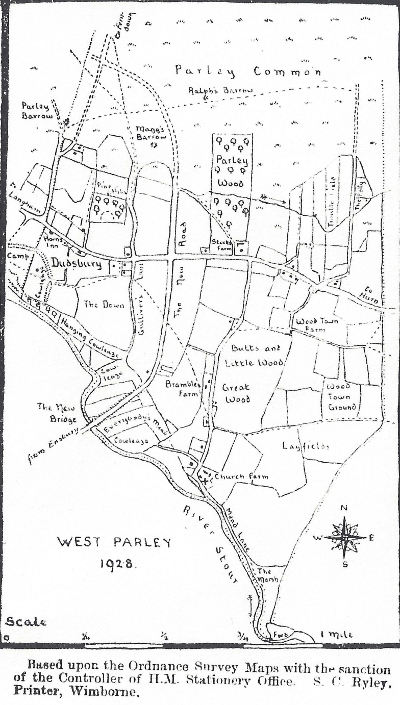LATER PARLEY
We have seen that in the 16th Century, Parley appears to have been divided into farms, several of which exist to this day, and from being a single estate passed into the hands of many owners.
This involved the enclosure of the open fields, although the enclosures in many cases seem to have followed the boundaries of the old 'shots'. These enclosures were doubtless necessary from an economic point of view, and we hope that they did not involve great hardships to the smaller holders, as happened in so many cases. The heath was still unenclosed, and it was not until later that it was parcelled out among the freeholders in proportion to the extent of their holdings.
Of 17th Century Parley there is practically no record, but by the 18th Century the Parish differed little from its condition in quite recent times.
In 1763, Church Farm, the advowson of the living and a fishery on the Stour were purchased by Charles Brune of Plumber, whose ancestors had held the neighbouring Manor of East Parley since 1290, when King Edward I granted it to his chamberlain, William le Brun and Isoda his wife, who was one of the Maids of Honour to Queen Eleanor. Church Farm is now in the possession of Lieut-Col. C.R. Prideaux-Brune of Prideaux Place, Padstow, Cornwall.
In 1753, great improvements took place in the main roads of East Dorset; the Ringwood - Poole and the Ringwood - Wimborne Roads, which meet at Tricketts Cross were then made across the heath, and the old crossing of the Moors River at Palmer's Ford was abandoned and St. Leonards Bridge was built farther North. The new turnpike was administered by the "Ringwood Trust" the name of which may still be seen on the roadside milestones.
The population of West Parley was 180 in 1801, and in 1851 had increased to to 286, but in 1861 had fallen to 268. As the town of Bournemouth grew, with its never failing demand for labour, so the population of West Parley dwindled, especially in times of agricultural depression. In the memory of living men some 40 cottages have been demolished or allowed to fall into ruin. A mud-built house soon disappears once the roof is allowed to become dilapidated.
Within recent years the tide has turned and several new houses have been built; they are, no doubt, healthier and more comfortable to live in, but they have not the charm of their predecessors, not do their staring walls and asbestos roofs merge into the landscape but remain for ever something alien and a sad token of what is likely to come to our village.
In 1839 a complete survey of the Parish was made by the Tithe Commissioners. Up to this date, tithes had been paid in kind, but it was now agreed to commute these for the more convenient payment in money.
One can imagine the inconvenience of paying and collecting "One penny per head on Poultry for the tithe of Eggs" or even "The left shoulder of every fatted Calf, killed for the House" and "One halfpenny for hearth money or smoke money"
Incidentally the Terrier and Tithe Map give us a most valuable account of the Parish, not only as regards owners, occupiers, holdings and land but also as regards field names.
Some of these have been already mentioned, others indicate area, such as "Four Acres" others preserve the names of their original owners as "Magg's Close" or Benjamin's" or position as "Brick Kiln Ground" or "Barn Field" or shape as "Crooked Close".
We do not know what tragedy gave "Gallow's Acre" its name, and are more attracted to "Ferny Close" or "Bushy How". "Trouble field" and "The Folly" are the apt names given to attempted enclosures on the barren heath, which have now returned to fern and furze.
In 1912, the New Road from Ensbury to Ferndown was made, crossing the River by the New Bridge. The first bridge, despite its newness, subsided and had to be rebuilt.
Previous to this, communication with Bournemouth was by Redhill Ferry or by road via Longham and Kinson.
 Whatever may be in store for our Village, it is to be hoped that wisdom may guide those responsible for its development; that Dudsbury Camp and the Round Barrows on the Heath may be preserved, that the ancient Church may not suffer from the hands of too zealous 'restorers' and that sufficient green fields may be left for the healthy recreation and pleasure of Parley folk.
Whatever may be in store for our Village, it is to be hoped that wisdom may guide those responsible for its development; that Dudsbury Camp and the Round Barrows on the Heath may be preserved, that the ancient Church may not suffer from the hands of too zealous 'restorers' and that sufficient green fields may be left for the healthy recreation and pleasure of Parley folk.